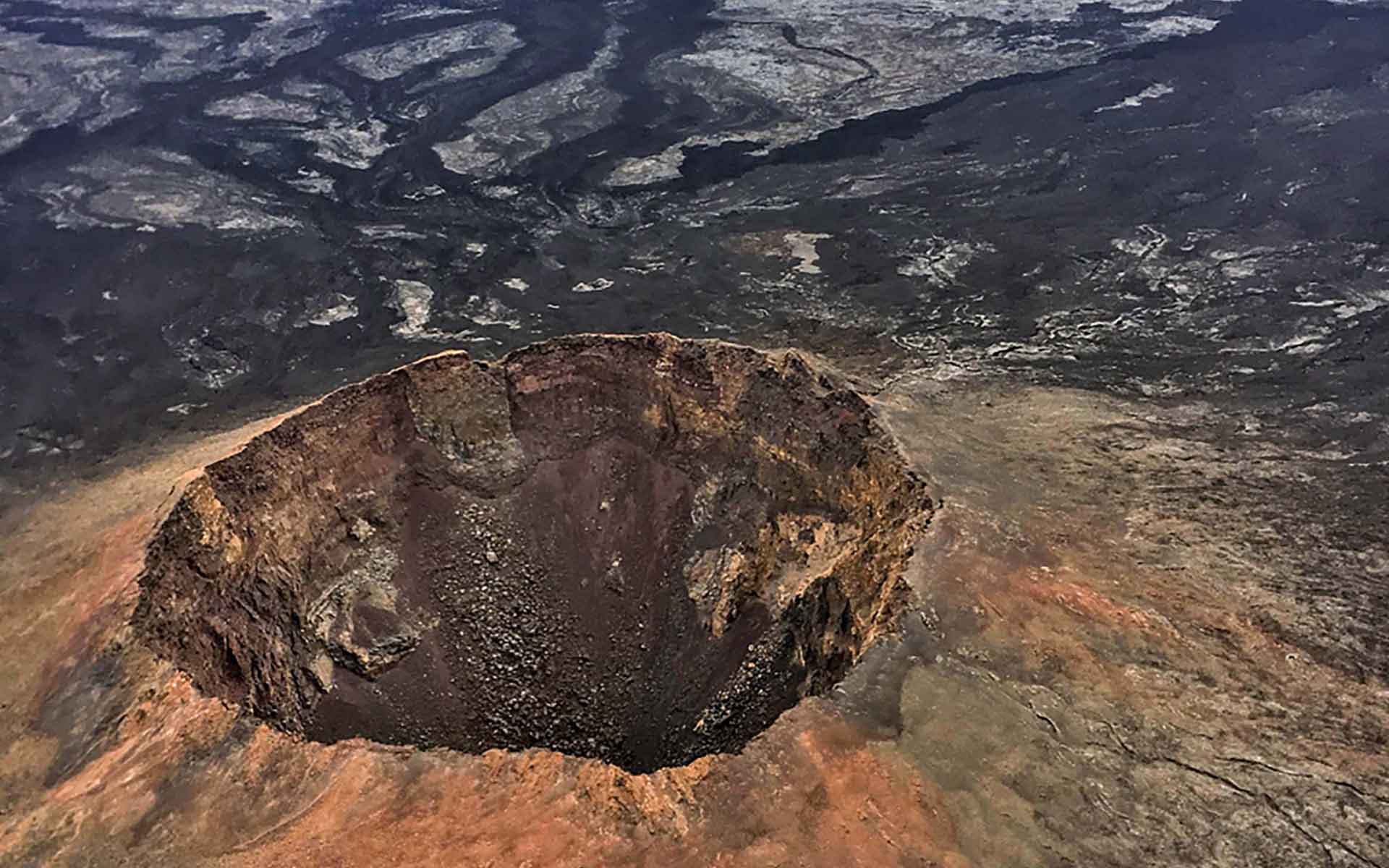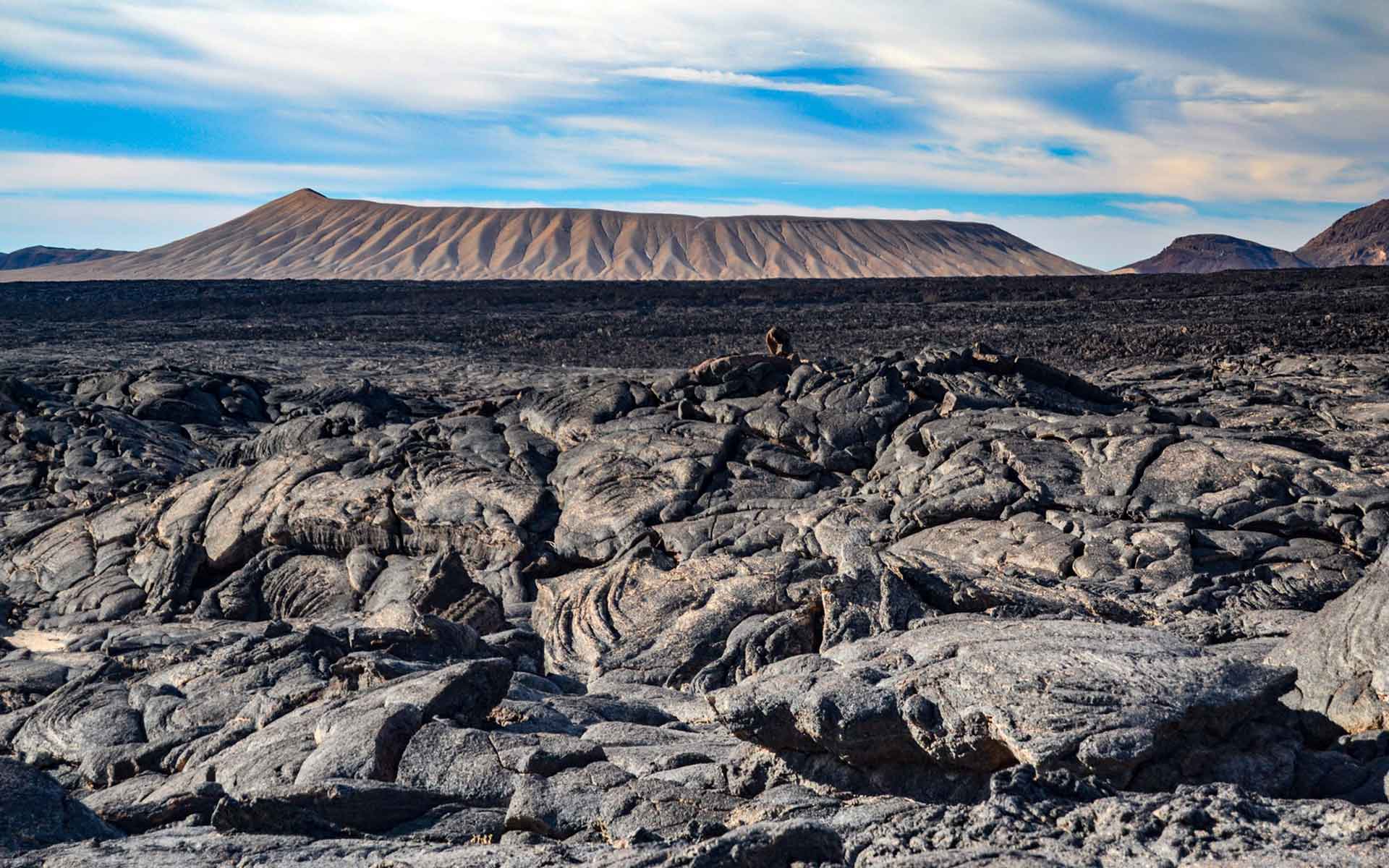
Jabal Qidr crater from the air. Jebel Abyad rhyolitic tuff ring in the background surrounded by basaltic pahoehoe lava flow field from Jabal Qidr.
Geological Period
Holocene (Pleistocene)
Main geological interest
Volcanology
Location
25°43’13.0″N, 39°56’36.0″E
Jabal Qidr crater from the air. Jebel Abyad rhyolitic tuff ring in the background surrounded by basaltic pahoehoe lava flow field from Jabal Qidr.
The largest historic basaltic volcanic cone in intracontinental settings within a pleistocene rhyolitic tuff ring and lava dome field.
Jabal Qidr and its volcanic environment is a global type of example for the full spectrum of volcanic geoforms, volcanic deposits, and interaction of active volcanism with early human civilizations of a longlived (mature) small-volume (monogenetic) volcanic field. The variations from rhyolitic to basaltic intraplate magmatism and the dramatic changes of eruption styles from phreatomagmatic to violent Strombolian within a geologically short time frame provides a type of site to explore the breadth of type of volcanism we can face within intracontinental settings.
- Geological description
Jabal Qidr is the youngest volcanic eruption within the largest intracontinental bimodal volcanic field in the Arabian Peninsula (Camp et al., 1991). It is a large volcanic cone with a relative elevation of about 400 meters. Its part of a roughly N-S trending fissure that emitted large volume of basaltic pahoehoe tube-fed lava flows that reached Bronze Age (~5000 years) occupation sites of the so called “desert kites” (Kempe and Al-Malabeh, 2013; Kennedy et al., 2021). The eruption is inferred to have reached sub-Plinian explosive intensity and produced thick ash plain through a violent Strombolian style eruption that reached at least 20 km from the central vent (Németh and Moufti, 2017). The crater of Jabal Qidr is a spectacular ~200-meter-deep and 300-meter-wide depression showing evidence of violent explosive processes and pit collapses due to lava flow drainage through the feeder fissure system. The lava flows have superb pahoehoe lava flow surface textures following early Holocene stream networks occupied by early human civilizations. Jabal Qidr erupted in volcanic field dominated by monogenetic rhyolite that generated tuff rings forming spectacular white lava domes and tuff rings such as Jebel Abyad and Jebel Bayda respectively (Moufti and Németh, 2014). This site demonstrates the volcanic geodiversity of mature, small-volume intracontinental volcanic field (Moufti and Németh, 2016; Németh and Moufti, 2017).
- Scientific research and tradition
The remoteness and the closed societal aspects of the region until recent years prevented prevented access for research in the region. This has changed in the last decade resulting in an accelerated rate of global research within volcanology, archaeology and volcanic geoheritage studies.
The Jabal Qidr region geological map based on the Geological Map of the Khaybar Quadrangle, Sheet 25D, Kingdom of Saudi Arabia (Compiled by R Dhellemmes & J Delfour 1979) on an ALOS-PALSAR 12.5 DEM-generated contour map. Labels: b2 = basalt 3-9 My; b3 = basalt 0.3-3 My; tr – trachyte/benmoreit/ commendaite 0.2-4.5 My; trp = trachyte pyroclastics; b4 = basalt 30 – 300 ky; b5 = recent basalt <30 ky; b5p = recent pyroclastics, e.g., ash plains. Numbers refer to measured radiometric ages in My.
- Reference
Camp, V.E., Roobol, M.J. and Hooper, P.R. (1991) ‘The Arabian continental alkali basalt province: Part II. Evolution of Harrats Khaybar, Ithnayn, and Kura, Kingdom of Saudi Arabia’, GSA Bulletin, 103(3), pp. 363–391. Available at: https://doi.org/10.1130/0016-7606(1991)103<0363:TACABP>2.3.CO;2.
Kempe, S. and Al-Malabeh, A. (2013) ‘Desert kites in Jordan and Saudi Arabia: Structure, statistics and function, a Google Earth study’, Quaternary International, 297, pp. 126–146. Available at: https://doi.org/10.1016/j.quaint.2013.02.013.
Kennedy, M.A. et al. (2021) ‘Dating the pendant burials of north-west Arabia: First radiometric results from the Khaybar Oasis, Saudi Arabia’, Arabian Archaeology and Epigraphy, 32(S1), pp. 183–197. Available at: https://doi.org/10.1111/aae.12199.
Moufti, M.R. and Németh, K. (2014) ‘The White Mountains of Harrat Khaybar, Kingdom of Saudi Arabia’, International Journal of Earth Sciences, 103(6), pp. 1641–1643. Available at: https://doi.org/10.1007/s00531-014-1022-9.
Moufti, M.R. and Nemeth, K. (2016) Geoheritage of Volcanic Harrats in Saudi Arabia. Heilderberg: Springer. Available at: https://doi.org/10.1007/978-3-319-33015-0.
Nemeth, K. and Moufti, M.R. (2017) ‘Geoheritage Values of a Mature Monogenetic Volcanic Field in Intra-continental Settings: Harrat Khaybar, Kingdom of Saudi Arabia’, Geoheritage, 9(3), pp. 311–328. Available at: https://doi.org/10.1007/s12371-017-0243-2.
- Author(s)
Károly Németh
Massey University, New Zealand; Institute of Earth Physics and Space Science, Hungary and Saudi Geological Survey, Kingdom of Saudi Arabia
Mohammed Rashad Moufti
King Abdulaziz University, Jeddah, Kingdom of Saudi Arabia


